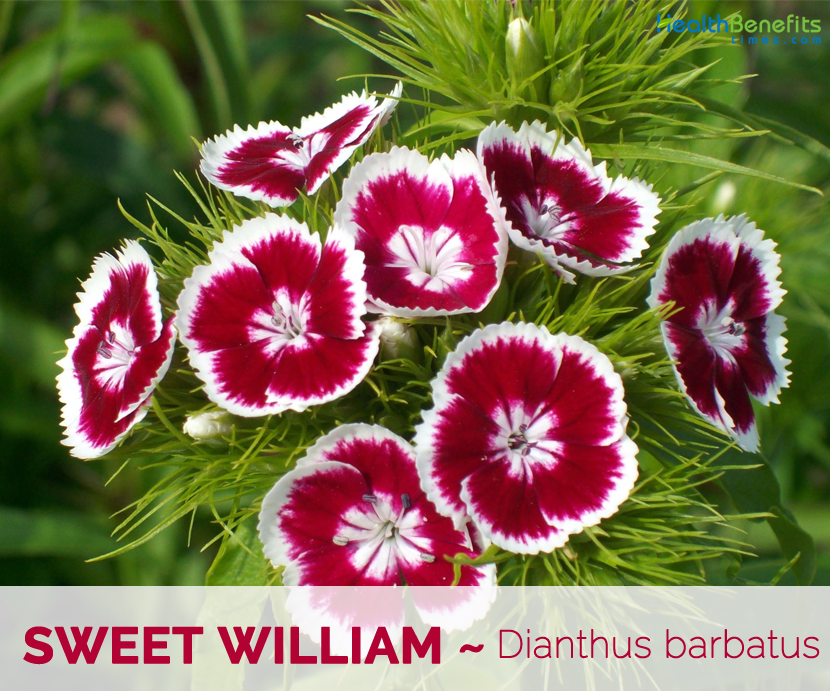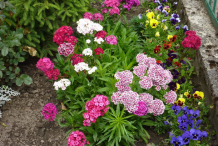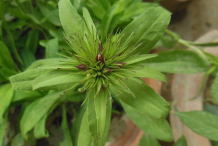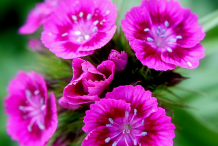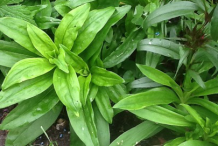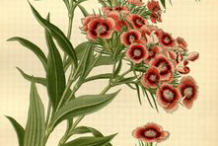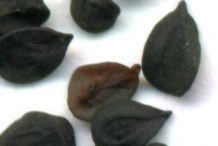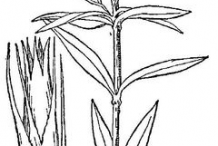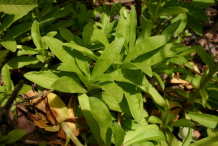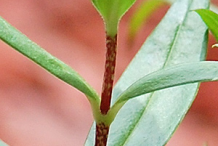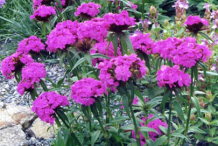Many sources contend that the flower was named for William Augustus, duke of Cumberland, who led British forces against the Jacobites at the Battle of Culloden in 1746. Other sources claim, however, that the name of the flower can be traced to the writings of Thomas Tusser, a 16th-century English poet. In Scotland the flower is known as stinking Willie or sour Billy.
Plant Description
Sweet William is an herbaceous biennial or short-lived perennial plant growing about 30–75 cm tall with flowers in a dense cluster of up to 30 at the top of the stems. The plant is found growing in sunny location and does best in rich, well-drained loamy, mildly alkaline soil but succeeds in most soils including moderately dry soil and partial shade. The plant has erected angular stems and green to glaucous, lanceolate blue green leaves that are 4–10 cm long and 1–2 cm broad, apex acute, base tapering. The plant is usually treated as a garden biennial, seeds are sown the first year producing flowering plants the second year.
Flower & fruit
Each flower is 2–3 cm diameter with five petals displaying serrated edges. Wild plants produce red flowers with a white base, but colors in cultivars range from white, pink, red, and purple to variegated patterns, sometimes with a contrasting eye, and with fringed petals that are bearded on the inside. Flowers may be fragrant, although many of the newer cultivars have no scent. The flowers are edible and may have medicinal properties. Sweet William attracts bees, birds, and butterflies.
The plant is available year round, with each stem producing a ‘spray’ of several flowers- the average being 10-15 blooms per stem. The average stem length is a minimum of 40cm and a maximum of 67cm. Each bloom opens into a delightfully rounded petal with a gorgeous rounded center. Flowers are followed by capsules that are sub oblong to ovoid, 4 valved, 1 cm across with smooth, compressed, brown ovoid seeds. Flowering normally takes place from Jul to August and seeds starts ripening from Aug to September.
Varieties
There are two varieties of Dianthus barbatus which are listed below
- Dianthus barbatus var. barbatus: Southern Europe. Leaves broader, up to 2 cm broad
- Dianthus barbatus var. asiaticus Nakai: Northeastern Asia. Leaves slenderer, not over 1 cm broad
Culinary uses
- Flowers are edible, have a mild flavor and are used as a garnish for vegetable and fruit salads, cakes, desserts, cold drinks, tea and sorbet.
- Petals of Sweet William will add zest to ice cream, sorbets, salads, fruit salad, dessert sauces, seafood and stir-fries.
Other Facts
- Sweet William is a popular ornamental plant in gardens, planted in pots, flats or in beds.
- Plant produces nectar that attracts birds, bees, moths and butterflies.
- In Scotland the flower is known as stinking Willie or sour Billy.
- Flower would make a lovely addition to a wedding bouquet, table centerpiece or just about any style of flower arrangement.
- Sweet William will attract hummingbirds and butterflies into the garden.
- This flower symbolizes gallantry.
References:
https://www.itis.gov/servlet/SingleRpt/SingleRpt?search_topic=TSN&search_value=20277#null
https://davesgarden.com/guides/pf/go/37998/
https://npgsweb.ars-grin.gov/gringlobal/taxonomydetail.aspx?id=13817
https://pfaf.org/user/Plant.aspx?LatinName=Dianthus+barbatus
http://www.missouribotanicalgarden.org/PlantFinder/PlantFinderDetails.aspx?kempercode=a573
http://www.floracatalana.net/dianthus-barbatus-l-subsp-barbatus
http://www.theplantlist.org/tpl/record/kew-2763865
https://plants.usda.gov/core/profile?symbol=DIBA
https://en.wikipedia.org/wiki/Dianthus_barbatus
https://aggie-horticulture.tamu.edu/wildseed/38/38.1.html
Comments
| Sweet William Quick Facts | |
|---|---|
| Name: | Sweet William |
| Scientific Name: | Dianthus barbatus |
| Origin | Southern Europe from the Pyrenees East to the Carpathians and the Balkans |
| Shapes | Capsule sub oblong to ovoid, 4 valved, 1 cm across |
| Name | Sweet William |
|---|---|
| Scientific Name | Dianthus barbatus |
| Native | Mountains of southern Europe from the Pyrenees East to the Carpathians and the Balkans |
| Common Names | Sweet-William, Sweetwilliam, Bearded pink, China carnation, sweet William pink |
| Name in Other Languages | Burmese : Mani Soythu Pan Catalan: Clavell de gitana, Clavell de pom Chinese : Tou Shi Zhu, Wǔcǎi shízhú (五彩石竹), Shí yàng jǐn (十样锦), Měiguó shízhú (美国石竹) Czech : Hvozdík Bradatý, Hvozdík Vousatý Danish : Busk Nellike, Studenter-Nellike Dutch : Duizendschoon English: Sweet-William, Sweetwilliam, Bearded pink, China carnation, sweet William pink, Estonian : Habenelk Esperanto : Dianto Barba Finnish : Harjaneilikka French : Oeillet Barbu, Oeillet Des Poètes, Oeillet de Girardin German : Bart-Nelke, Busch-Nelke, Brennende Liebe, Hermannstädter Veilchen, Herrische Blume, Marienröschen, Nägelblume, Steinnägelblume, Steinnägelchen, Tausendschönchen Hungarian: szakállos szegfü, szegfü, szegfüvirág, török szegfü Icelandic : Busknellik Italian : Garofano Montano Japanese : Amerika-Nadeshiko, Hosoba-Hige- Nadeshiko Norwegian : Busknellik Nynorsk, Norwegian: Busknellik Norwegian Bokmål: Busknellik Polish : Goździk Brodaty Portuguese: Cravina-roxa, Romanian: anghel, buruiene de ghiţei, buruiene de jerme, cocoşei, cuişoare, cărujea, cărînjea, de jerme, garoafa, garoafă de grădină, garoafă turcească, garofita, garofite de gradina, garofiţe, garofiţe de grădină, grozdică, gvordici, Inger, neghinele, pietrucele, puşca lupului, sacfiu, sacfiu nemţesc, sacfiu turcesc, sacfiu tărcat, samfiu, sanfiu, scaunul popii, scînteuţă, secfiu, susfirăgi, sălcuţă, ursinica, ursuele, ursărele, ursărele, vîzdoance ungureşti, zaschiu sălbatic, ţelfiu Slovašcina : Brkati Nageljček, Klinček Brkati, Nageljček, Sorta Slovencina: Klinček Bradatý Spanish : Clavel Imperial Swedish : Borstnejlika, Harjaneilikka Turkey : Hüsnüyusuf Ukrainian: Hvozdek Welsh : Penigan Barfog |
| Plant Growth Habit | Herbaceous biennial or short-lived perennial plant |
| Growing Climates | Sunny locations |
| Soil | Rich, well-drained loamy, mildly alkaline soil but succeeds in most soils including moderately dry soil and partial shade. |
| Plant Size | 30–75 cm tall |
| Stem | Erect angular stems |
| Leaf | Green to glaucous, lanceolate 4–10 cm by 1–2 cm wide, apex acute, base tapering |
| Flowering Periods | Jul to August |
| Flower | Flowers (2–3.5 cm across) numerous produced in clusters at the top of the stem; bracts 4 almost as long as calyx tube, with membranous, ciliate margins |
| Fruit Shape & Size | Capsule sub oblong to ovoid, 4 valved, 1 cm across |
| Seed | Smooth, compressed, brown ovoid seeds. |
| Flavor/Aroma | Spicy, clove-like scent |
| Varieties | • Dianthus barbatus var. barbatus • Dianthus barbatus var. asiaticus Nakai |
| Season | Aug to September |
| Propagation | Seeds, cuttings or division |


